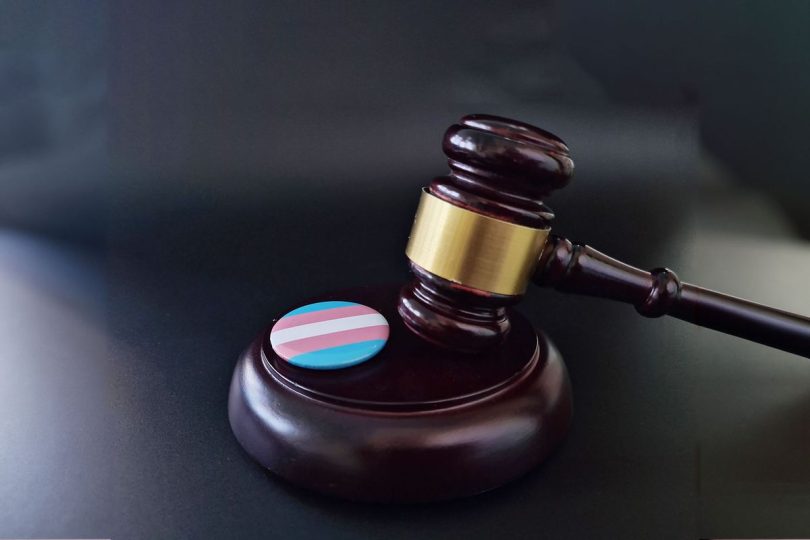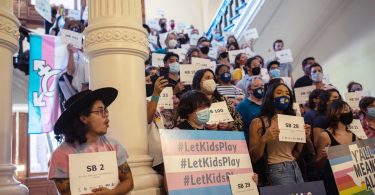“);
}
A man in South Carolina was convicted last week on federal charges for the 2019 killing of a Black transgender woman in the nation’s first gender identity-based hate crime trial.
The historic prosecution nearly five years after Pebbles LaDime “Dime” Doe’s death granted the woman and her loved ones, who celebrated the guilty verdict on social media, justice via the legal system that trans and gender non-conforming Americans don’t often receive. But experts caution that, in the current social and cultural climate, the trial is not enough.
Jurors found Daqua Lameek Ritter guilty last Friday of the 2019 hate crime murder of Doe after around four hours of deliberation, The Associated Press reported. Ritter, who now faces a maximum sentence of life in prison without parole, was also convicted of using a firearm in connection to the fatal crime and obstructing justice. His sentencing date has not yet been scheduled.
The guilty verdict arrived against a harrowing social backdrop colored in part by the growing prevalence of anti-LGBTQ, particularly anti-trans, rhetoric and conservative-led legislative efforts to limit the communities’ freedoms. The FBI in 2022 also saw a 32.9 percent increase in gender-identity-based hate crimes from 2021, while the Human Rights Campaign, which declared a state of emergency for LGBTQ Americans last summer, in the last four years recorded a spike in the fatal violence against gender expansive Americans. Ritter’s trial being the first of its kindraises concerns around how effectively the law the case was prosecuted under addresses the greater cause of the violence: widespread — and deepening — transphobia.
“Of course, it’s a win when anti-trans violence is recognized under the law, but there’s just such a wave of hate-motivated both attacks verbally and physically against trans folks now that this type of violence needs to be recognized and addressed more often,” said Jordan Woods, a University of Arizona professor of law who researches criminal justice issues affecting LGBTQ populations.
The lack of trials for violent hate crimes based on a victim’s gender identity under an act that is more than a decade old, the 2009 Matthew Shepard and James Byrd Jr. Hate Crime Prevention Act, is also glaring, Woods added, noting the dozens of trans and gender expansive people who have likely been killed because of gender identity bias since that time.
The 15-year-old Hate Crime Prevention Act criminalized willfully causing bodily injury — or attempting to do so with a deadly weapon — when done because of the victim’s sexual orientation or gender identity, among other protected categories.
The provision allows for more robust data collection on gender identity and sexual orientation-based hate crimes and grants the government authority to prosecute a wider range of those hate crimes that it did not previously have jurisdiction for, Woods explained. The law also allows the federal government to cooperate with and provide resources to a state or local hate crime investigation, particularly in states like South Carolina that do not have hate crime laws.
In those cases, the Department of Justice acts as a “second set of eyes” and determines whether the local or state jurisdiction conducted the most thorough and reasonable prosecution possible given the available evidence, according to David Stacy, the vice president of government affairs for the Human Rights Campaign.
“The other reason [for] having the U.S. DOJ there looking over their shoulder is there are prosecutors that we know in the past — and I’m sure in the present day — don’t want to prosecute these crimes or want to under prosecute the crime because they don’t care enough,” Stacy told Salon.
According to the AP, federal officials have previously prosecuted gender identity-based hate crimes, but the cases never reached trial. Most, like other crimes, Woods said, end in plea deals. The first gender-identity-based hate crime prosecution and conviction under the act occurred in 2017 after a Mississippi man pleaded guilty to killing Mercedes Williamson, a 17-year-old transgender girl whom he had a sexual relationship with, in 2015, according to CBS News. The perpetrator, Joshua Vallum, who was 29 at the time of his sentencing, received a 49-year prison sentence from the federal government on top of a state-level life sentence.
How data on these crimes are collected can also hinder the federal government’s ability to intervene. FBI statistics are voluntarily reported, Stacy said, and the local police officer on the beat must accurately identify the crime as bias-motivated — rather than a regular assault or homicide — in order to get the reporting right from the start. Inaccurate identification of the victims as their sex assigned at birth or by a deadname further complicates the reporting process.
While the documentation of hate crimes based on gender identity has improved with greater public awareness about the violence trans and gender-expansive people face, contributing in part to an increase in the number of reported cases, the total is likely much higher than what the government is able to record because of those early introduced inaccuracies, Shoshana Goldberg, the HRC’s public education and research director, told Salon.
“Another thing is, we are in a state of emergency,” added Goldberg, who leads the campaign’s fatal violence tracking efforts, citing an increase in anti-trans legislation, rhetoric and violence throughout the country.
“We’re seeing just a large spike in this happening against a political system that is really perpetuating and legitimizing stigma against trans folks, while also increasingly trying to push them out the spaces of public life as well as confine the spaces in which a person can exist,” she said.
The Human Rights Campaign has been tracking fatal violence against trans and gender non-conforming people since 2013, including both FBI-labelled hate crimes and other killings it identifies “where bias, hate and structural violence and stigma played a role,” according to its 2023 report.
The report found that half of all identified killings of trans and gender non-conforming people occurred in the last four years. It also saw that, of the 335 deaths the civil rights organization recorded since 2013, trans women comprised 83 percent of the victims, with trans women of color amounting to 75 percent of the victims. Black trans women, including Doe, specifically account for 62 percent of all known victims recorded since 2013.
“There’s multiple marginalization here. People are in a vulnerable spot economically, they’re in a vulnerable spot in their relationships, or their families, they don’t have the same support systems. All of these things combined result in a greater incidence,” Stacy said, explaining why Black trans women and trans women of color are more impacted by the violence.
“One of the things we see in a lot of bias-motivated crime, and is particularly true in relation to trans women, is they tend to be more violent,” he added. “When violence results the violence tends to be more extreme and therefore more likely to result in more injury, more death because of the hatred involved. So, the dehumanization that comes with that — that’s another factor that you layer on top.”
Since 2013, guns have been involved in nearly 70 percent of all fatalities the HRC identified, the report said. Over half of all killings by an intimate partner, which amount to just over 20 percent of all the HRC-recorded cases, as in Doe’s case, involved a gun.
The trial over Doe’s killing lasted four days and revolved around the secret relationship between her and Ritter, who was angered by the public exposure of their affair in Allendale, South Carolina, witness testimony and text messages obtained by the FBI indicated, according to the AP. Prosecutors alleged Ritter shot Doe three times with a .22 caliber handgun to prevent further disclosure of his relationship with a trans woman.
Text messages obtained by the FBI show that Ritter wanted to keep their relationship a deep secret, prosecutors said. He reminded Doe to scrub their messages from her phone, and hundreds of texts from the month before her death were deleted.
Their conversations became strained shortly before her death, the AP reported. One message from July 29, 2019, saw Doe complain about Ritter’s lack of reciprocity when it came to her generosity toward him. Ritter replied that he believed they both understood she didn’t need the “extra stuff.” Ritter also told Doe that his main girlfriend at the time had called him a homophobic slur after learning of their relationship. Doe, in a July 31 text, said she felt used and told Ritter he should never have let his girlfriend find out about their relationship.
A defense lawyer argued at trial that no physical evidence pointed to Ritter as the perpetrator, pointing to how state law enforcement never processed a gunshot residue test Ritter took voluntarily and arguing Ritter being seen in her car hours before her murder should be no surprise given their intimate relationship and frequent car rides.
April Carrillo, an assistant professor of criminal justice at the University of South Dakota, sees the transphobia in Doe’s murder overlapping with the circumstances around the recent death of Nex Benedict. Benedict, a 16-year-old trans nonbinary student in Oklahoma who used he/they pronouns, died in early February, a day after sustaining severe head injuries, according to local police, from a fight in a high school bathroom.
Benedict, who the Owasso Police Department said did not die due to head trauma based on preliminary autopsy results, told a school resource officer that, after pouring water on older students’ heads for making fun of him and his friend, they had been jumped in the girl’s restroom by older students, swept to the ground and beaten on the floor. A 2022 Oklahoma law prohibiting people from using a bathroom that didn’t align with their sex assigned at birth had forced Benedict to use the girl’s bathroom at their school. Their mother also told the media that they had been bullied since the beginning of the school year for their gender identity.
A final autopsy and toxicology reports are pending, and the police have not declared a cause of death at this time. The case is not currently being investigated as a hate crime, but police told independent news Substack Popular Information, murder charges are “on the table.”
Want a daily wrap-up of all the news and commentary Salon has to offer? Subscribe to our morning newsletter, Crash Course.
Carrillo, a criminologist who focuses on LGBTQ people and the legal system, told Salon that they aren’t convinced a hate crime law and any resulting convictions could really address the virulent transphobia at the root of these kinds of incidents.
“It’s not like [the perpetrator is] going to go to prison and then also be educated about gender identity or queer people in general,” Carrillo said, noting that the carceral system is not designed for reformation and adding: “We just blame this whole systemic issue of transphobia and violence on the singular person and wipe our hands of it in the legal system and go, ‘Alright, we got ’em.'”
Instead, Carrillo posits that, on a public level, improving youth engagement with trans, gender expansive and LGBTQ people through public events like drag queen story hours, LGBTQ history-inclusive school curricula and challenging bias in institutions of knowledge will broker broader acceptance that can undercut the impetus for these crimes.
For its part, the criminal justice system should create an atmosphere of cultural competence — where practitioners are aware of LGBTQ people and issues, trained on inclusive terminology and approach exchanges with gender-expansive people with nuance and respect, they continued, citing the textbook “Culture, Diversity and Criminal Justice.”
Providing federal funding to programs that address other types of violence that LGBTQ Americans face at equal or disproportionate rates — like sexual or domestic violence — would also serve to prevent violent incidents, Stacy explained, offering as an example funding for greater access to shelters for trans and LGBTQ people fleeing abuse.
“When you put all those things together, you create a culturally safe environment,” Carrillo added, emphasizing how officials’ “really disgusting” rhetoric plays a role in the current climate. “When you create something culturally safe, it’s almost a top-down thing. When you have members of the community, stakeholders, saying, ‘Hey, we value these folks in our community. We find their identities valid. They’re just human beings,’ other people are more inclined to be like, ‘Oh, yeah, sure, of course.'”
Read more
about anti-LGBTQ attacks
By Tatyana Tandanpolie
Tatyana Tandanpolie is a staff writer at Salon. Born and raised in central Ohio, she moved to New York City in 2018 to pursue degrees in Journalism and Africana Studies at New York University. She is currently based in her home state and has previously written for local Columbus publications, including Columbus Monthly, CityScene Magazine and The Columbus Dispatch.
MORE FROM Tatyana Tandanpolie







